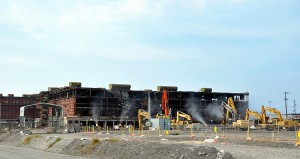
Workers begin demolishing the last section of the K-25 building on Tuesday. K-25 was built to enrich uranium for atomic bombs during World War II and was once the world’s largest building under one roof, but it’s been unused for decades. (Photo courtesy U.S. Department of Energy/UCOR)
Demolition work began Tuesday on the last section of the historic K-25 Building, which was erected to enrich uranium for atomic bombs during World War II and was once the world’s largest building under one roof.
Most of the building, which is in west Oak Ridge, has already been demolished. Only a small section of the east wing remains at the former mile-long, U-shaped building.
K-25 was built during the top-secret Manhattan Project in World War II to enrich uranium for nuclear weapons through a process known as gaseous diffusion. Those operations ended in 1964.
The building is at the former K-25 site, which is now known as Heritage Center and is slowly being converted into a massive industrial park.
UCOR, the U.S. Department of Energy’s cleanup contractor in Oak Ridge, announced the start of demolition work on the remaining six units at K-25 on Tuesday. There were 54 units originally.
Plans once called for the North End, which was at the bottom of the U, to be preserved for historic purposes. But an agreement signed in July 2012 by federal, state, and local historic preservation groups allowed for the entire building to be demolished, including the North End, while still commemorating the historic significance of the site.
Demolition work on the North End was completed in January.
Plans have called for completing the demolition work on the remaining six units in the east wing by 2015.
The K-25 Building demolition project is the largest in DOE’s EM program. Earlier this year, federal officials said the project has an approved value of up to $1.4 billion, although they said the total cost—including expenses for maintenance, repairs, and security patrols dating back to the mid-1980s—could come in under budget at roughly $1.1 billion.
About 350 workers have been involved in the demolition project, which started in December 2008 under Bechtel Jacobs Co. LLC, DOE’s former cleanup contractor in Oak Ridge. UCOR began working at the K-25 site, now known as East Tennessee Technology Park, in August 2011.
Construction on the 44-acre K-25 Building started in November 1943 and was finished in August 1945, about the time World War II ended. The K-25 site was used to enrich uranium for commercial use after the war. K-25 also worked with sites in Portsmouth, Ohio, and Paducah, Ky., to enrich uranium for nuclear weapons.
“Beginning this final stage of demolition marks the end of an era,†Steve Dahlgren, UCOR’s deactivation and decommissioning manager, said in a Tuesday press release. “This building served the nation well for over 60 years and played a role in ending World War II and the Cold War. Now it will soon be safely on the ground and in the history books.â€
The building’s west wing was demolished under Bechtel.
In the first two years of the UCOR contract, the company said Tuesday, it safely and successfully demolished the north end and the east wing, except for the six units that were presumed to be contaminated with technetium-99 and required further deactivation. Tc-99 is a very mobile, slow-decaying radioactive material and presented unique challenges.
Dahlgren said getting the last six units to this point was a long, difficult road.
UCOR said it found unexpected challenges when the company arrived at the East Tennessee Technology Park, which includes Heritage Center and the nearby Horizon Center. Among them were large sections of K-25 that were still deemed “crit credibleâ€â€” meaning materials were still present that could theoretically cause a nuclear criticality to occur. Workers had to perform all the work necessary to declare the area “crit incredible,†which meant finding ways to remove and dispose of a number of these challenging materials, the press release said. Then the building had to be rendered “cold, dark, and dry,†which means all hazardous materials removed and all sources of energy cut off. Then, the building was condemned.
“I can’t say enough about the performance of these crews,†Dahlgren said in the release. “Every day, they faced all the issues and challenges associated with the work, in particular the work involved in deactivating and tearing down a 70-year-old, extremely complex building. They have performed brilliantly, and their performance—especially their safety performance—has been remarkable.â€
Here is more information from the press release:
Years ago, during west wing demolition, materials for which a disposition path had not been determined were moved out and into other parts of the building so that demolition could continue. In an area called Vault 1X, a litany of legacy waste had been collected. There was a collection of tanks that had been part of the process and had been disconnected and placed in the south end of the east wing. There were also components called NaF (sodium fluoride) traps, which were used during operations to separate uranium from intermediate gases in the process system. There was no history indicating that these traps were purged before K-25 operations ceased.
In the north end, which has now been demolished, UCOR also discovered items that had been removed from the west wing before demolition, including a collection of high-risk equipment (HRE) and items called monoliths, which turned out to be large blocks of uranium-containing components encased in concrete.
“Back in the day, they encased these components in concrete to protect them for security purposes,†said Dahlgren.
The most urgent, “critical path†issues identified for the demolition of the building were the monoliths and high-risk equipment (HRE) in the north end, and Vault 1X, surge tanks, and the NaF traps in the Tc-99 area, because demolition could not proceed in those areas until those materials were removed.
The monoliths and HRE had to be moved out of the building before that section of the building could be deemed crit incredible. The concrete in the monoliths had to be chipped away and the uranium content mined out of the components in an on-site facility called the segmentation shop. The HRE had to be opened, mined and repackaged to meet disposal criteria. Depending on the contents, they were either disposed of at the on-site Environmental Management Waste Management Facility or shipped west to either Nevada or Utah.
In the case of the surge tanks, UCOR built enclosures around them where they stood, bought special cutting tools, and trained people to do the work. The uranium was mined out of the tanks and the hulls stayed in place to be disposed as part of the building demolition.
When K-25 was operational, the NaF traps were part of the final uranium removal process. Sodium fluoride pellets were used to trap the uranium, and these particular traps still contained uranium materials from when the facility was shut down decades ago. The NaF traps are each about the size of a household hot water heater and range in weight from 150 pounds to 800 pounds each. They are especially hazardous to workers because they contain fluorine compounds that can generate hydrogen fluoride when they come into contact with moisture in the air. First, UCOR had to find ways to work safely in the deteriorating building. The walls, floors and ceiling have gaping holes, and workers couldn’t walk on the floor safely without reinforcements.
The NaF traps were lifted through holes cut in the roof and were stored until they could be characterized and a final disposition path determined. Lessons learned were subsequently used to safely remove similar NaF traps at K-25’s sister facility, K-27.
Prior to UCOR’s arrival, the prevailing thought was that due to the chemical characteristics of technetium—it is extremely mobile and travels quickly—the last Tc-99 section in its entirety would need to be packed up and shipped west. Through characterization, however, it was determined that most of the building structure and some of the process gas equipment could be disposed on site at EMWMF, saving significant dollars.
With a new “Go Orange†initiative, work that previously would have been tediously done by workers in the buildings will now be done more safely and expediently in the field during the demolition process.
Under the previous approach, workers in the Tc-99 area would have spent weeks cutting out contaminated pipes that can’t be disposed on site, then loading them for shipment. Instead, they painted them with bright paint and left them in place. As the last six units are demolished, these bright components will be segregated and loaded by heavy equipment in the field.
Compressors and converters were previously an issue because they were taken into the non-destructive assay (NDA) shop, where NDA was performed. Instead, as part of the deactivation and demolition of the Tc-99 units, these components will be decontaminated and sprayed with fixative in the demolition field. The NDA equipment will be brought into the field, and a packaging, assay, and ship production line will be established. Heavy equipment will also be used to package piping in the field for shipping.
UCOR is a partnership between URS and CH2M Oak Ridge LLC. In addition to deactivating and demolishing the K-25 building, UCOR is responsible for other specific scopes of work at ETTP, the Y-12 National Security Complex, and the Oak Ridge National Laboratory.
Note: This story was updated at 2:20 a.m. Sept. 19.





Leave a Reply